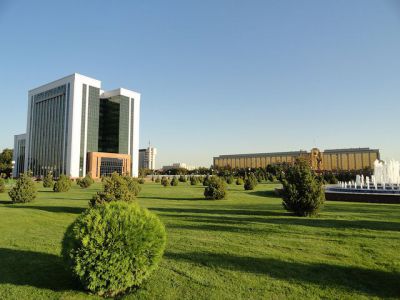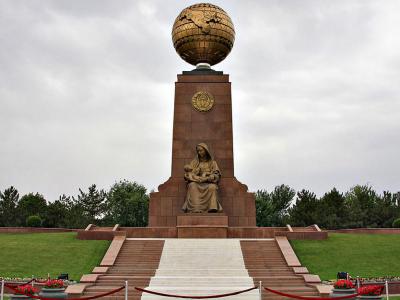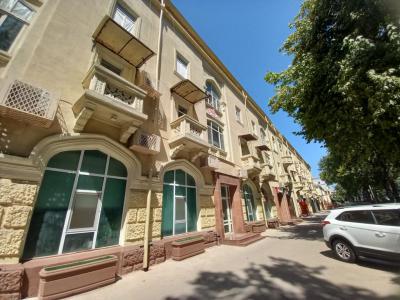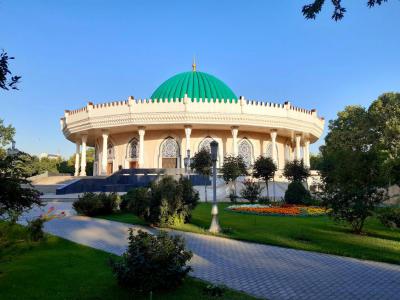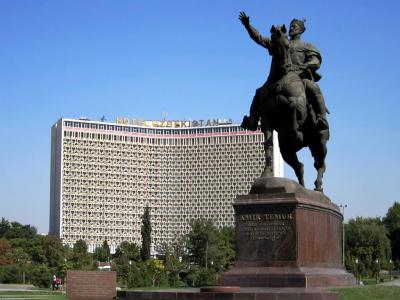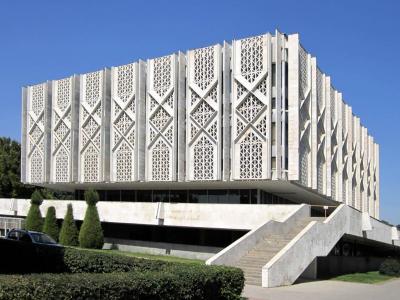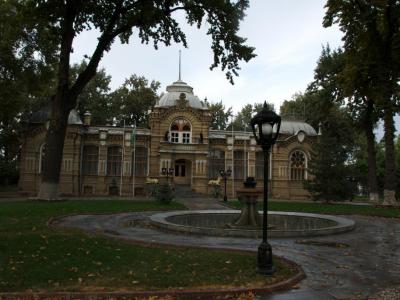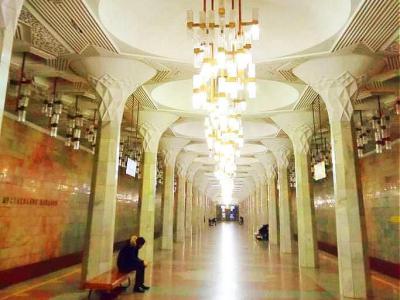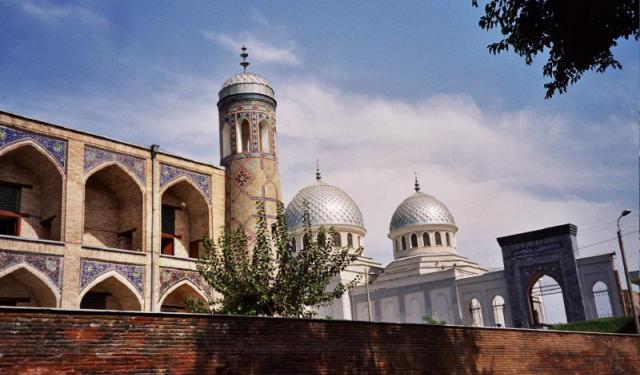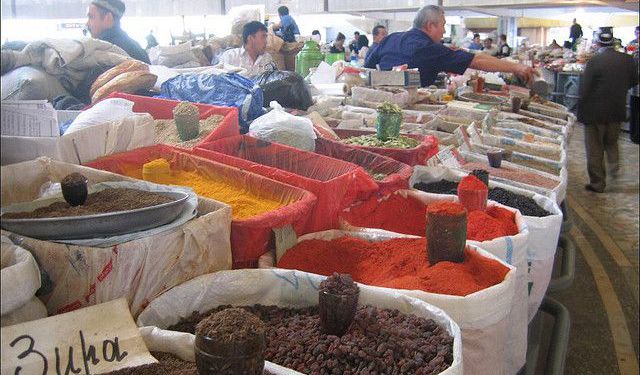
Tashkent Introduction Walking Tour (Self Guided), Tashkent
The capital city of Uzbekistan, Tashkent, also historically known as Chach, is the country's cultural, industrial and administrative hub. First settled some time between the 5th and 3rd centuries BC, throughout its long history the city has had various changes in political and religious affiliations. The name Tashkent comes from the Turkic tash and kent, which literally means "Stone City" or "City of Stones".
Before Islamic influence started in the mid-8th century AD, Tashkent was part of the Sogdian and Turkic cultures. After being destroyed by Genghis Khan in 1219, Tashkent was rebuilt and profited from the Silk Road.
During the reign of Amir Timur, in the 14th-15th centuries, Tashkent was part of Timur's empire. From the 18th to the 19th century, it became an independent city-state, before it was re-conquered by the Khanate of Kokand. In 1865, Tashkent fell to the Russian Empire and became the capital of Russian Turkestan.
In Soviet times, it witnessed major growth and demographic changes. Largely destroyed in the 1966 earthquake, Tashkent was rebuilt as a model Soviet city, with wide streets planted with shade trees, parks, immense plazas for parades, fountains, monuments, and acres of apartment blocks. This was achieved with the help of the Soviet republics, who sent "battalions of fraternal peoples" and urban planners to help resurrect the city.
The Tashkent Metro, built during that time, was the seventh underground railway launched in the former USSR, and is still one of only two subway rapid transit systems operating in Central Asia. Its stations – like Mustakillik Maidoni (Independence Square) station, richly decorated with national Uzbek ornaments – are among the most picturesque in the world.
At the time of the collapse of the Soviet Union, in 1991, Tashkent was the fourth-largest city in the USSR, and a center of learning in the fields of science and engineering.
Due to the destruction following the 1917 revolution and, later, the 1966 earthquake, little remains of the city's traditional architectural heritage. Tashkent, however, is rich in museums and Soviet-era monuments. These include the Temurid History Museum, which houses relics from the Timurid dynasty period, and the nearby enormous State Museum of History of Uzbekistan, housed in the ex-Lenin Museum building, which has in its collection some rare centuries-old Buddhist artifacts.
The Palace of Grand Duke Romanov is another prominent location, currently administered by the Ministry of Foreign Affairs. The city’s skyline is distinguished by Tashkent Tower, which offers city views from its observation deck.
To explore these and other notable sights of Uzbekistan's capital, follow this self-guided introductory walk.
Before Islamic influence started in the mid-8th century AD, Tashkent was part of the Sogdian and Turkic cultures. After being destroyed by Genghis Khan in 1219, Tashkent was rebuilt and profited from the Silk Road.
During the reign of Amir Timur, in the 14th-15th centuries, Tashkent was part of Timur's empire. From the 18th to the 19th century, it became an independent city-state, before it was re-conquered by the Khanate of Kokand. In 1865, Tashkent fell to the Russian Empire and became the capital of Russian Turkestan.
In Soviet times, it witnessed major growth and demographic changes. Largely destroyed in the 1966 earthquake, Tashkent was rebuilt as a model Soviet city, with wide streets planted with shade trees, parks, immense plazas for parades, fountains, monuments, and acres of apartment blocks. This was achieved with the help of the Soviet republics, who sent "battalions of fraternal peoples" and urban planners to help resurrect the city.
The Tashkent Metro, built during that time, was the seventh underground railway launched in the former USSR, and is still one of only two subway rapid transit systems operating in Central Asia. Its stations – like Mustakillik Maidoni (Independence Square) station, richly decorated with national Uzbek ornaments – are among the most picturesque in the world.
At the time of the collapse of the Soviet Union, in 1991, Tashkent was the fourth-largest city in the USSR, and a center of learning in the fields of science and engineering.
Due to the destruction following the 1917 revolution and, later, the 1966 earthquake, little remains of the city's traditional architectural heritage. Tashkent, however, is rich in museums and Soviet-era monuments. These include the Temurid History Museum, which houses relics from the Timurid dynasty period, and the nearby enormous State Museum of History of Uzbekistan, housed in the ex-Lenin Museum building, which has in its collection some rare centuries-old Buddhist artifacts.
The Palace of Grand Duke Romanov is another prominent location, currently administered by the Ministry of Foreign Affairs. The city’s skyline is distinguished by Tashkent Tower, which offers city views from its observation deck.
To explore these and other notable sights of Uzbekistan's capital, follow this self-guided introductory walk.
How it works: Download the app "GPSmyCity: Walks in 1K+ Cities" from Apple App Store or Google Play Store to your mobile phone or tablet. The app turns your mobile device into a personal tour guide and its built-in GPS navigation functions guide you from one tour stop to next. The app works offline, so no data plan is needed when traveling abroad.
Tashkent Introduction Walking Tour Map
Guide Name: Tashkent Introduction Walking Tour
Guide Location: Uzbekistan » Tashkent (See other walking tours in Tashkent)
Guide Type: Self-guided Walking Tour (Sightseeing)
# of Attractions: 8
Tour Duration: 2 Hour(s)
Travel Distance: 4.0 Km or 2.5 Miles
Author: nataly
Sight(s) Featured in This Guide:
Guide Location: Uzbekistan » Tashkent (See other walking tours in Tashkent)
Guide Type: Self-guided Walking Tour (Sightseeing)
# of Attractions: 8
Tour Duration: 2 Hour(s)
Travel Distance: 4.0 Km or 2.5 Miles
Author: nataly
Sight(s) Featured in This Guide:
- Mustakillik Maydoni (Independence Square)
- Happy Mother Monument
- Alisher Navoi Avenue
- Temurid History Museum
- Amir Timur Square
- State Museum of History
- Palace of Grand Duke Romanov
- Mustaqillik Maidoni (Independence Square) Metro Station
1) Mustakillik Maydoni (Independence Square) (must see)
Independence Square (Uzbek: Mustaqillik Maydoni) is a central-most and largest square in Tashkent, a place where public celebrations, military parades and other special events take place. As a matter of fact, this is more like a huge park rather than a square, replete with trees and flower beds amid monuments and fountains, a showcase of modern Uzbekistan.
The history of this place goes back over a century, to 1865, when, following the capture of Turkestan by Russia, the new imperial administration began transforming Tashkent into a European-like city. The reconstruction involved, among other things, the building of residence for the Turkestan Governor-General, the so-called "White House".
The square in front of the house was named Cathedral Square, after the Spaso-Preobrazhensky Cathedral, located on the opposite side. In the early 1930s, under the Soviets, the cathedral was demolished and the square was renamed Red. In 1936, they had a Lenin monument placed here. Twenty years later, Red Square became known as Lenin Square.
After the devastating earthquake of 1966, a radical reconstruction of the square was carried out in compliance with the general plan of resurrection of Tashkent. In 1967, a modern "concrete-and-glass" edifice of the Council of Ministers of the Uzbek SSR, on the south side of the square, was completed. The entire reconstruction was finished in 1974, on the eve of the 50th anniversary of the Uzbek SSR. That same year, the old Lenin monument was moved to Samarkand, and its place was taken by a new, bigger monument to the same Vladimir Lenin, set on top of a marble plinth that was taller than a ten-storey building.
Following Uzbekistan's independence in 1991, Lenin Square was renamed Independence Square and the bronze statue of Lenin was dismantled. Its marble plinth, however, survived and was topped with a golden globe (featuring a map of Uzbekistan), known since as the Independence Monument. Later, in front of it, another statue, of a happy mother with a child, symbolizing Motherland, was added. Installed in 2006, it marked the completion of the total reconstruction of the area.
Another notable mark, at the square's entrance, is the silver Arch of Independence, with figures of storks around the fountain. Overlooking the square from the western side there are also a number of imposing administrative buildings, such as the Council of Ministers, the Senate of Uzbekistan, and the Ministry of Finance.
The history of this place goes back over a century, to 1865, when, following the capture of Turkestan by Russia, the new imperial administration began transforming Tashkent into a European-like city. The reconstruction involved, among other things, the building of residence for the Turkestan Governor-General, the so-called "White House".
The square in front of the house was named Cathedral Square, after the Spaso-Preobrazhensky Cathedral, located on the opposite side. In the early 1930s, under the Soviets, the cathedral was demolished and the square was renamed Red. In 1936, they had a Lenin monument placed here. Twenty years later, Red Square became known as Lenin Square.
After the devastating earthquake of 1966, a radical reconstruction of the square was carried out in compliance with the general plan of resurrection of Tashkent. In 1967, a modern "concrete-and-glass" edifice of the Council of Ministers of the Uzbek SSR, on the south side of the square, was completed. The entire reconstruction was finished in 1974, on the eve of the 50th anniversary of the Uzbek SSR. That same year, the old Lenin monument was moved to Samarkand, and its place was taken by a new, bigger monument to the same Vladimir Lenin, set on top of a marble plinth that was taller than a ten-storey building.
Following Uzbekistan's independence in 1991, Lenin Square was renamed Independence Square and the bronze statue of Lenin was dismantled. Its marble plinth, however, survived and was topped with a golden globe (featuring a map of Uzbekistan), known since as the Independence Monument. Later, in front of it, another statue, of a happy mother with a child, symbolizing Motherland, was added. Installed in 2006, it marked the completion of the total reconstruction of the area.
Another notable mark, at the square's entrance, is the silver Arch of Independence, with figures of storks around the fountain. Overlooking the square from the western side there are also a number of imposing administrative buildings, such as the Council of Ministers, the Senate of Uzbekistan, and the Ministry of Finance.
2) Happy Mother Monument
The successful depictions of politics with “a human face”, especially in the light of the concept of patriotism, are extremely rare in art. So much so, in fact, that managing such a combination is like putting together the incompatible sometimes. Yet in Tashkent they managed to achieve exactly that, 100%, in the form of the Monument to a Happy Mother.
Installed right in front of the landmark Independence Monument in the eponymous square, this six-meter bronze sculpture is simple and solemn at the same time. The ensemble features a seated figure of a Uzbek woman with a kind face and happy eyes, carefully holding in her arms a small child. The woman clearly appears eager to cherish her priceless treasure and to raise him worthy of his homeland.
But make no mistake – this monument is not the personification of “maternal warmth”, but is a purely political metaphor. The image of the woman symbolizes Motherland, while that of the child is interpreted as the country's people and their future.
The monument was created by sculptors Ilkhom and Kamol Jabbarov. Its installation, in 2006, marked the completion of the total remodeling of Independence Square complex.
Installed right in front of the landmark Independence Monument in the eponymous square, this six-meter bronze sculpture is simple and solemn at the same time. The ensemble features a seated figure of a Uzbek woman with a kind face and happy eyes, carefully holding in her arms a small child. The woman clearly appears eager to cherish her priceless treasure and to raise him worthy of his homeland.
But make no mistake – this monument is not the personification of “maternal warmth”, but is a purely political metaphor. The image of the woman symbolizes Motherland, while that of the child is interpreted as the country's people and their future.
The monument was created by sculptors Ilkhom and Kamol Jabbarov. Its installation, in 2006, marked the completion of the total remodeling of Independence Square complex.
3) Alisher Navoi Avenue
Alisher Navoi Avenue is one of the oldest and central-most thoroughfares of Tashkent. Prior to 1893, it was called Toshkocha and Kattakocha, and then was known as Shaikhontohur.
Back in the old days, the street used to connect the city proper with the artisans-inhabited neighborhoods. Among the traces from that period, still in place, is the mausoleum of Sheikh Khavandi Tohur, built in the 15th century. Other than this and the 19th-century Eshonquli Dodkhoh madrasah, there were practically no large buildings in the area.
Under the Russian colonial rule, in the second half of the 19th and the early 20th century, the street became busy linking the new, Russian-built part of town with the old part. In 1884, the first Russian school was opened here, the first tram line was put into operation, and, in 1908, the first kerosene lanterns in Tashkent were installed.
In 1938, the avenue got its current name, marking the 500th anniversary of the nationally-beloved poet and thinker, Alisher Navoi, one of the pioneers of vernacular language in the literature of Uzbekistan. His statue, outside the Alisher Navoi State Museum of Literature, was installed in 1949. Another statue of Navoi, in the "Alley of Poets", was inaugurated on February 9, 1991, on the occasion of his 550th anniversary.
The vast majority of the buildings currently seen here were constructed during the 1930s-70s. These include the Ministry of Agriculture and Water Management (1930), the Central Telegraph, the "Vatan" cinema (1937-1940), and the Palace of Culture and Labor (1940) presently occupied by the Museum of Literature and the Young Spectators' Theater.
Many of them feature typical look of Stalinist Empire architecture, with strong “national” highlights borrowed from Central Asian traditional motifs. Symmetry, columns, large front entrances and impressive balconies are in stark contrast to the later architecture. The Navoi Museum itself is exemplary of this, as is the building across from it, and further down the street eastward, the current Ministry of Health. Toward the Anhor canal, residential buildings from that era have a different kind of charm – slightly run-down but clearly majestic in their heyday.
Navoi Avenue is also an important shopping destination; its section between Independence Square and Circus is lined on both sides with numerous stores and boutiques. Here, you can shop till you drop for pretty much everything, from clothes to accessories to organic food to souvenirs. And to make it even more pleasant and less exhausting, there's no shortage of cafes and restaurants either.
Back in the old days, the street used to connect the city proper with the artisans-inhabited neighborhoods. Among the traces from that period, still in place, is the mausoleum of Sheikh Khavandi Tohur, built in the 15th century. Other than this and the 19th-century Eshonquli Dodkhoh madrasah, there were practically no large buildings in the area.
Under the Russian colonial rule, in the second half of the 19th and the early 20th century, the street became busy linking the new, Russian-built part of town with the old part. In 1884, the first Russian school was opened here, the first tram line was put into operation, and, in 1908, the first kerosene lanterns in Tashkent were installed.
In 1938, the avenue got its current name, marking the 500th anniversary of the nationally-beloved poet and thinker, Alisher Navoi, one of the pioneers of vernacular language in the literature of Uzbekistan. His statue, outside the Alisher Navoi State Museum of Literature, was installed in 1949. Another statue of Navoi, in the "Alley of Poets", was inaugurated on February 9, 1991, on the occasion of his 550th anniversary.
The vast majority of the buildings currently seen here were constructed during the 1930s-70s. These include the Ministry of Agriculture and Water Management (1930), the Central Telegraph, the "Vatan" cinema (1937-1940), and the Palace of Culture and Labor (1940) presently occupied by the Museum of Literature and the Young Spectators' Theater.
Many of them feature typical look of Stalinist Empire architecture, with strong “national” highlights borrowed from Central Asian traditional motifs. Symmetry, columns, large front entrances and impressive balconies are in stark contrast to the later architecture. The Navoi Museum itself is exemplary of this, as is the building across from it, and further down the street eastward, the current Ministry of Health. Toward the Anhor canal, residential buildings from that era have a different kind of charm – slightly run-down but clearly majestic in their heyday.
Navoi Avenue is also an important shopping destination; its section between Independence Square and Circus is lined on both sides with numerous stores and boutiques. Here, you can shop till you drop for pretty much everything, from clothes to accessories to organic food to souvenirs. And to make it even more pleasant and less exhausting, there's no shortage of cafes and restaurants either.
Sight description based on Wikipedia.
4) Temurid History Museum
The Temurid History (aka Amir Timur) Museum in Tashkent is one of the most beautiful museums in Uzbekistan. It opened in 1996 and since then has become one of the city's top tourist attractions.
After Uzbekistan became independent in 1991, much attention was given to the revival of the nation's spiritual and cultural heritage, including recognition of historical persons who played an important role in the world's civilization. Among those was Amir Temur (aka Tamerlane), the Turco-Mongol warlord, politician and reformer, patron and promoter of science, education, trade, and culture (fine arts, music and poetry, and craft). Having established a great centralized state, he united many peoples under his rule, laying foundations of the so-called Timurid Renaissance in Asia.
The then President of Uzbekistan, Islam Karimov, encouraged celebration of Timur, linking the Mongol ruler's achievements with his own style of governance. Karimov declared 1996 to be the “Year of Amir Temur”, and the 660th anniversary of Timur was celebrated with pomp in Uzbekistan. Subsequently, the republic resolved to have a national museum in the capital, solely dedicated to the Timurid history.
The museum's ceremonial opening, on 18 October 1996, was attended by many local and foreign dignitaries. Built in the medieval style, with a blue cupola resembling that of the Gur-e-Amir mausoleum in Samarkand, the museum building is a true architectural landmark.
Inside, there is a priceless collection of artifacts belonging to the Temurids era, comprising over 5,000 artifacts. More than 2,000 items, permanently displayed, are thematically grouped. The main focus is on the genealogy of Amir Temur, his coming to power, the military campaigns of Sahib Kiran, diplomatic and trade relations, workmanship, urban development and landscaping, as well as science and education. The exhibits include maps, weapons, copper and silver coins, miniatures, rare manuscripts, potteries, and jewelry.
Each year, more than two million people visit the museum. For those interested in the oriental culture and history, and particularly the reign of the Temurid dynasty, this place is a must.
After Uzbekistan became independent in 1991, much attention was given to the revival of the nation's spiritual and cultural heritage, including recognition of historical persons who played an important role in the world's civilization. Among those was Amir Temur (aka Tamerlane), the Turco-Mongol warlord, politician and reformer, patron and promoter of science, education, trade, and culture (fine arts, music and poetry, and craft). Having established a great centralized state, he united many peoples under his rule, laying foundations of the so-called Timurid Renaissance in Asia.
The then President of Uzbekistan, Islam Karimov, encouraged celebration of Timur, linking the Mongol ruler's achievements with his own style of governance. Karimov declared 1996 to be the “Year of Amir Temur”, and the 660th anniversary of Timur was celebrated with pomp in Uzbekistan. Subsequently, the republic resolved to have a national museum in the capital, solely dedicated to the Timurid history.
The museum's ceremonial opening, on 18 October 1996, was attended by many local and foreign dignitaries. Built in the medieval style, with a blue cupola resembling that of the Gur-e-Amir mausoleum in Samarkand, the museum building is a true architectural landmark.
Inside, there is a priceless collection of artifacts belonging to the Temurids era, comprising over 5,000 artifacts. More than 2,000 items, permanently displayed, are thematically grouped. The main focus is on the genealogy of Amir Temur, his coming to power, the military campaigns of Sahib Kiran, diplomatic and trade relations, workmanship, urban development and landscaping, as well as science and education. The exhibits include maps, weapons, copper and silver coins, miniatures, rare manuscripts, potteries, and jewelry.
Each year, more than two million people visit the museum. For those interested in the oriental culture and history, and particularly the reign of the Temurid dynasty, this place is a must.
5) Amir Timur Square (must see)
Situated in the very heart of Tashkent, Amir Temur Square (Uzbek: Amir Temur xiyoboni) is the main town square in the capital, equally popular with locals and tourists.
The square was built in 1882 by the Russian architects, Nikolai Ulyanov and Mikhail Chernyayev, on the site of a public park at the intersection of two main lanes, Moscow Street (now Amir Timur Street) and Kaufman Street (now Milza Ulugh Beg Street), and was initially called Konstantinovskaya Square.
It was not paved, getting all dusty in dry weather and muddy when it rained. In 1913, a multi-figure monument to the first Turkestan governor-general, Konstantin Kaufman, was erected here, upon which the square was renamed Kaufmansky.
After the 1917 Russian Revolution, the square was renamed once again, this time as Revolution Square; the Kaufman monument was dismantled, in 1919, but its granite pedestal remained. During the late 1940s, it was reused to accommodate the statue of Joseph Stalin, and was ultimately removed only in 1961, as part of the nationwide de-stalinization campaign. In 1968, a sculpture of Karl Marx was put in its place.
Before that, in the 1950s, the square underwent significant reconstruction. Owing to its convenient central location, it regularly drew attention of the people who wished to express their political views. Here, alongside frequent communist rallies, starting from the late 1960s, the Crimean Tatars, who were deported by Stalin to Uzbekistan in 1944, also demonstrated several times, without authorization, demanding to be allowed to return to Crimea. Throughout the 1980s, this place was a popular hangout with both “golden” youth and small-time criminals, attracted by the nearby cafe-restaurant (open until late hours), several ice cream parlors, and the alleys lined with benches.
In 1994, three years into Uzbekistan's independence, the square was renamed Amir Timur. The Karl Marx monument was dismantled and a bronze equestrian statue to Tamerlane was installed. Simultaneously, all the drinking and entertainment establishments in the vicinity were liquidated in a bid to tackle crime, prostitution, and idle pastime.
In 2009, another round of comprehensive embellishment was carried out bringing in new walkways, benches and modernized lighting, as well as well chopping down some of the old trees. Their place was taken by the newly-planted sakuras, chestnut and other trees. The effort proved worthy, as, beginning from the 2010s, the area has once again become regularly crowded with townsfolk, prompting the authorities to reopen the previously closed eateries and souvenir shops.
The square was built in 1882 by the Russian architects, Nikolai Ulyanov and Mikhail Chernyayev, on the site of a public park at the intersection of two main lanes, Moscow Street (now Amir Timur Street) and Kaufman Street (now Milza Ulugh Beg Street), and was initially called Konstantinovskaya Square.
It was not paved, getting all dusty in dry weather and muddy when it rained. In 1913, a multi-figure monument to the first Turkestan governor-general, Konstantin Kaufman, was erected here, upon which the square was renamed Kaufmansky.
After the 1917 Russian Revolution, the square was renamed once again, this time as Revolution Square; the Kaufman monument was dismantled, in 1919, but its granite pedestal remained. During the late 1940s, it was reused to accommodate the statue of Joseph Stalin, and was ultimately removed only in 1961, as part of the nationwide de-stalinization campaign. In 1968, a sculpture of Karl Marx was put in its place.
Before that, in the 1950s, the square underwent significant reconstruction. Owing to its convenient central location, it regularly drew attention of the people who wished to express their political views. Here, alongside frequent communist rallies, starting from the late 1960s, the Crimean Tatars, who were deported by Stalin to Uzbekistan in 1944, also demonstrated several times, without authorization, demanding to be allowed to return to Crimea. Throughout the 1980s, this place was a popular hangout with both “golden” youth and small-time criminals, attracted by the nearby cafe-restaurant (open until late hours), several ice cream parlors, and the alleys lined with benches.
In 1994, three years into Uzbekistan's independence, the square was renamed Amir Timur. The Karl Marx monument was dismantled and a bronze equestrian statue to Tamerlane was installed. Simultaneously, all the drinking and entertainment establishments in the vicinity were liquidated in a bid to tackle crime, prostitution, and idle pastime.
In 2009, another round of comprehensive embellishment was carried out bringing in new walkways, benches and modernized lighting, as well as well chopping down some of the old trees. Their place was taken by the newly-planted sakuras, chestnut and other trees. The effort proved worthy, as, beginning from the 2010s, the area has once again become regularly crowded with townsfolk, prompting the authorities to reopen the previously closed eateries and souvenir shops.
6) State Museum of History
The State Museum of History of Uzbekistan, originally known as the National Museum of Turkestan, was founded in 1876. It is the oldest, and also the largest, museum in Central Asia. It came into being upon the initiative of a group of Russian scientists, members of the Turkestan branch of the Moscow Society of Lovers of Natural History, Anthropology and Ethnography.
During the 20th century, the museum repeatedly changed its location. Currently, it occupies the former quarters of the Lenin Museum, purpose-built in 1970 as the Tashkent branch of the Central Museum of Vladimir Lenin in Moscow to mark the 100th anniversary of the founder of the Soviet state.
Simple, but monumental, almost square in plan, this building looks light and is well visible from all sides. It has four above-ground and two underground floors with an introductory hall and exposition rooms (on the two upper floors). The overhanging upper part of the edifice is lined with openwork Panjar-style panels, which simultaneously serve as enclosing structures and sun protection.
The museum's collection accounts for more than 250,000 exhibits in the field of archaeology, history, and ethnography, dating from the Stone Age to the present day, asserting Uzbekistan as one of the key centers of Eastern civilization. The displayed artifacts, found in the country, are unique and include ancient ceramics and fabrics, a large number of ancient coins and burial relics, as well as some rare archival materials, manuscripts, historical documents and photographs. The Muslim section of the museum features calligraphy pieces and regal edicts dated from the Tamerlane dynasty to the last emirs of Bukhara.
There is also a wealth of ethnic art, household items, and costumes from different parts of Uzbekistan. Among them is a large bronze Saka cauldron, decorated with animal figurines, dated from the 4th-5th centuries BC, and the sculpture of the Buddha from the 1st century AD, found during archaeological dig in the Surkhandarya region.
All of these and more allow visitors a chance to learn about the history of both the Uzbeks and other peoples who used to inhabit, and still do, the territory of Central Asia and particularly that of modern Uzbekistan.
During the 20th century, the museum repeatedly changed its location. Currently, it occupies the former quarters of the Lenin Museum, purpose-built in 1970 as the Tashkent branch of the Central Museum of Vladimir Lenin in Moscow to mark the 100th anniversary of the founder of the Soviet state.
Simple, but monumental, almost square in plan, this building looks light and is well visible from all sides. It has four above-ground and two underground floors with an introductory hall and exposition rooms (on the two upper floors). The overhanging upper part of the edifice is lined with openwork Panjar-style panels, which simultaneously serve as enclosing structures and sun protection.
The museum's collection accounts for more than 250,000 exhibits in the field of archaeology, history, and ethnography, dating from the Stone Age to the present day, asserting Uzbekistan as one of the key centers of Eastern civilization. The displayed artifacts, found in the country, are unique and include ancient ceramics and fabrics, a large number of ancient coins and burial relics, as well as some rare archival materials, manuscripts, historical documents and photographs. The Muslim section of the museum features calligraphy pieces and regal edicts dated from the Tamerlane dynasty to the last emirs of Bukhara.
There is also a wealth of ethnic art, household items, and costumes from different parts of Uzbekistan. Among them is a large bronze Saka cauldron, decorated with animal figurines, dated from the 4th-5th centuries BC, and the sculpture of the Buddha from the 1st century AD, found during archaeological dig in the Surkhandarya region.
All of these and more allow visitors a chance to learn about the history of both the Uzbeks and other peoples who used to inhabit, and still do, the territory of Central Asia and particularly that of modern Uzbekistan.
7) Palace of Grand Duke Romanov
Born in St Petersburg in the middle of the nineteenth century into the House of Romanov, he had a very privileged childhood. Most royal children were brought up by nannies and servants so by the time Nikolai had grown up he lived a very independent life having become a gifted military officer and an incorrigible womanizer. He had an affair with a notorious American woman Fanny Lear. In a scandal related to this affair, he stole three valuable diamonds from the revetment of one of the most valuable family icons. He was declared insane and he was banished to Tashkent.
He lived for many years under constant supervision in the area around Tashkent in the southeastern Russian Empire (now Uzbekistan) and made a great contribution to the city by using his personal fortune to help improve the local area. He was also famous in Tashkent as a competent engineer and irrigator, constructing two large canals, the Bukhar-aryk (which was poorly aligned and soon silted up) and the much more successful Khiva-Aryk, later extended to form the Emperor Nicholas I Canal, irrigating 12,000 desyatinas, 33,000 acres (134 km2) of land in the Hungry Steppe between Djizak and Tashkent. Most of this was then settled with Slavic peasant colonisers.
In 1890 he ordered the building of his own palace in Tashkent to house and show his large and very valuable collection of works of art and the collection is now the center of the state Museum of Arts of Uzbekistan.
He lived for many years under constant supervision in the area around Tashkent in the southeastern Russian Empire (now Uzbekistan) and made a great contribution to the city by using his personal fortune to help improve the local area. He was also famous in Tashkent as a competent engineer and irrigator, constructing two large canals, the Bukhar-aryk (which was poorly aligned and soon silted up) and the much more successful Khiva-Aryk, later extended to form the Emperor Nicholas I Canal, irrigating 12,000 desyatinas, 33,000 acres (134 km2) of land in the Hungry Steppe between Djizak and Tashkent. Most of this was then settled with Slavic peasant colonisers.
In 1890 he ordered the building of his own palace in Tashkent to house and show his large and very valuable collection of works of art and the collection is now the center of the state Museum of Arts of Uzbekistan.
Sight description based on Wikipedia.
8) Mustaqillik Maidoni (Independence Square) Metro Station (must see)
The Mustaqillik Maydoni (Independence Square) metro station feels eerily like a transplant from the Moscow Metro of the 1930s, even though it was built some 40 years later. The station opened on 6 November 1977, as part of the inaugural section of the Tashkent Metro. Prior to 1 November 1991, it was called "V. I. Lenin Maidoni" ("Vladimir Iliich Lenin Square"), and was renamed in the 1990s, following the collapse of the Soviet Union, along with the square itself.
Inside you will find ornate white columns of Nurata marble contrasting the peach-coloured walls, in the vestibules, lined with Gazgan marble slabs. The plinth is finished with red Emelyanovsky granite, while the floor is paved with polished slabs of red and gray granite in the ethnic Uzbek pattern.
The station’s interior features a massive bas-relief bronze screen depicting joyous Uzbeks waving karnays (10 foot-long brass ceremonial trumpets) over their heads, flanked by clusters of dancing maidens and flag-waving citizens. There is also a dazzling array of crystal chandeliers in the domes hung from the ceiling along the perimeter, and trains that closely resemble enlarged versions of those boxy tin toys, printed a fraction out of register, that encapsulated Soviet childhood.
The Mustaqillik Maydoni station was specifically presented to the Spanish royal couple – King Juan Carlos I and his wife, Queen Sophia – during their trip to Tashkent.
Inside you will find ornate white columns of Nurata marble contrasting the peach-coloured walls, in the vestibules, lined with Gazgan marble slabs. The plinth is finished with red Emelyanovsky granite, while the floor is paved with polished slabs of red and gray granite in the ethnic Uzbek pattern.
The station’s interior features a massive bas-relief bronze screen depicting joyous Uzbeks waving karnays (10 foot-long brass ceremonial trumpets) over their heads, flanked by clusters of dancing maidens and flag-waving citizens. There is also a dazzling array of crystal chandeliers in the domes hung from the ceiling along the perimeter, and trains that closely resemble enlarged versions of those boxy tin toys, printed a fraction out of register, that encapsulated Soviet childhood.
The Mustaqillik Maydoni station was specifically presented to the Spanish royal couple – King Juan Carlos I and his wife, Queen Sophia – during their trip to Tashkent.
Sight description based on Wikipedia.
Walking Tours in Tashkent, Uzbekistan
Create Your Own Walk in Tashkent
Creating your own self-guided walk in Tashkent is easy and fun. Choose the city attractions that you want to see and a walk route map will be created just for you. You can even set your hotel as the start point of the walk.
Islamic Architecture Walking Tour
A visit to Uzbekistan is like leafing through the charred chapters of the Silk Road. Nowhere is this ambiance more exemplified than within the Islamic architecture adorning the streets of Tashkent.
One such architectural jewel is the Kukeldash Madrasah, dating back to the late 16th century. There is talk of making it into a museum, but it is currently still being used as a religious school.
... view more
Tour Duration: 2 Hour(s)
Travel Distance: 3.6 Km or 2.2 Miles
One such architectural jewel is the Kukeldash Madrasah, dating back to the late 16th century. There is talk of making it into a museum, but it is currently still being used as a religious school.
... view more
Tour Duration: 2 Hour(s)
Travel Distance: 3.6 Km or 2.2 Miles
Shopping in Tashkent
In the East they say, "A guest on your doorstep is happiness in your home!". Indeed, the Uzbeks, like no other people, are happy to welcome foreigners to their exotic world of aromas, tastes and cordial relationships manifested in authentic local food and products. In Tashkent you can find both of these, and in a great variety, on the street markets (bazaars), in smaller shops and big... view more
Tour Duration: 2 Hour(s)
Travel Distance: 6.0 Km or 3.7 Miles
Tour Duration: 2 Hour(s)
Travel Distance: 6.0 Km or 3.7 Miles
The Most Popular Cities
/ view all
